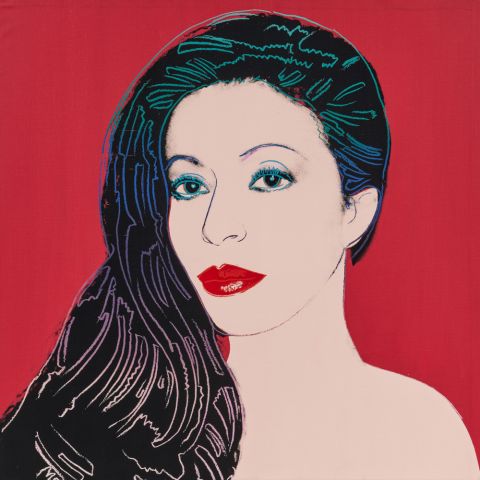
Lot 45 | Karin Kneffel | Hühnerhof
1957 Marl
Title: Hühnerhof.
Date: 1985.
Technique: Oil on canvas.
Measurement: 175.5 x 120cm.
Notation: Signed and dated verso lower right: K. Kneffel 1985.
Frame/Pedestal: Framed.
The work is listed on the artist's official website under the year of creation. (www.kneffel.de; here with a different date)
Provenance:
- Galerie Max Hetzler, Cologne
- Postbank Collection (adhesive label)
- Corporate collection, Germany
- Kneffel's artistic concern is not the creation of illusion, but rather the exposure of the illusionistic effects of painting
- The work is considered an outstanding early example of her media-critical approach
Painting as an object of investigation
In the early 1980s, Karin Kneffel studied under the sculptor Johannes Brus and the painters Norbert Tadeusz and Gerhard Richter at the Düsseldorf Art Academy. Her characteristic style of painting developed from the combination of various approaches of her former teachers: in addition to an eclectic combinatorics and increased attention to colouring, her artistic development revolves above all around an analytical examination of the medium of painting. From the very beginning, she investigated the mechanisms of illusion, exploring the painterly ability to deceive in order to reveal the artificiality of the created pictorial realities themselves.
Kneffel achieved great international recognition in the 2000s with her paintings of fruit, whose deceptive authenticity and striking visual language on oversized, monumental formats challenge perception. The banal pictorial object stands here in tense contrast to its sometimes wall-filling presence and the significance attributed to it as a result. Kneffel emphasises the discrepancy between motif and painting style, between authentic existence and the (falsifying) process of depiction.
Art history and artificiality
In her early animal portraits, created in the 1980s, chickens, cows, sheep and other farm animals populate the picture surface. In the art-historical tradition, this genre of portrait was reserved for aristocratic personnel and served a representative purpose. Instead of lavishly decorated kings and wealthy burghers, Kneffel now depicts the animalistic protagonists of rural life without pomp or posturing. Kneffel draws on art history to present variations of visualisation and to reveal the variety of falsifying stylistic devices used by painters when dealing with their subjects. The undisguised animal in its natural environment is also at the mercy of the appropriating gaze of the artist - and later of the viewers of her works. Her portraits point to the artificiality of the forms of representation, to conventions and clichés in visual culture. Kneffel is not interested in reproducing reality. Rather, she is concerned with the reproduction of artificial visual worlds.
Rigid stage set
Hühnerhof" also impressively illustrates Kneffel's media-reflexive, image-critical approach. The painting proves to be the image of a fiction. A gathering of chickens on an earthy ground against a sky of impenetrable leaden blue-grey is captured with a vigorous impasto brushstroke. Several hens are crowded together in the foreground of the painting, while a cockerel is perched on a haystack in the centre. The cropped nature of the scenically limited pictorial space does not allow any conclusions to be drawn about the spatial surroundings; on the contrary, the uniform lighting makes the depicted scene look like an unnaturally frozen stage set.
Simulation, emptying of meaning and new painterly realities
By using an old masterly technique and drawing on a subject that was particularly popular in Dutch genre paintings of the 17th century, Karin Kneffel picks up on a tradition that is now exhausted, however, degenerating into a mere pictorial formula without content. Kneffel's sophisticated play with the simulation and emptying of meaning of catchy categories such as ‘rural idyll’ and the expectations associated with them holds up a mirror to painting.
In her increasingly complex works, Kneffel presents the familiar, luring viewers into supposedly familiar territory, only to confront them with the conditions of their reception and throw them back on themselves without any foundation. "One of my favourite sentences about painting is by John Berger, something like this: 'The paradox of painting is that it invites the viewer into its interior space so that he can view the world outside from there." (Karin Kneffel quoted from ‘Interview with Walter Smerling and Karin Kneffel on 7 March 2024 in the artist's studio’, in: exhib. cat. Come In, Look Out, MKM Museum Küppersmühle for Modern Art, Duisburg Munich, 2024, p. 193)
Bettina Haiss
Print this lot | Recommend lot |
Conditions of this Lot
Statutory Turnover Tax, VAT is declared
27.00 % buyer’s premium on the hammer price
7% VAT on the total of hammer price and buyer’s premium
Estimated shipping costs for this lot:
Arrangement after the auction.
Karin Kneffel Germany Neorealism Hyperrealism Contemporary Art 1980s Framed Chicken Painting Oil Animal
More lots which could be of your interest
- Estimate: 120.000 - 180.000 €
03.12.2025 - ca.18:33Modern | Post War | Contemporary | Galerie Thomas | The Jagdfeld Collection | Auction 03.12.2025






